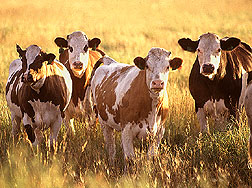This page has been archived and is being provided for reference purposes only. The page is no longer being updated, and therefore, links on the page may be invalid.
New Diagnostic Tool Will Aid in Eradicating Cattle TuberculosisBy Linda McGrawOctober 24, 1997 A new diagnostic test takes only 2 to 3 days to detect the bacterium that causes cattle tuberculosis, an improvement over current diagnostic methods that take 2 to 3 months. Mycobacterium bovis--the culprit in cattle tuberculosis--is very similar to two other bacteria: M. avium and M. paratuberculosis. The inability to distinguish between these similar organisms has slowed down the U.S. Department of Agriculture's goal of eradicating cattle tuberculosis by the year 2000. Scientists with USDA's Agricultural Research Service in Ames, Iowa, developed the new diagnostic test at the request of USDA's Animal and Plant Health Inspection Service (APHIS). APHIS works with state animal health inspection agencies and U.S. livestock producers to eradicate cattle TB. The test uses polymerase chain reaction (PCR), a technique that makes millions of copies of targeted genetic material found only in M. bovis. Making so many copies of the targeted DNA allows easy identification of M. bovis, which couldn't be seen before the PCR amplification. Extensive tests in other laboratories have proven that this piece of DNA isn't present in other mycobacterial species. The researchers checked the PCR test by examining 99 known cases of TB in cattle and elk. In 93 percent of the cases, they could make an accurate diagnosis within 2 to 3 days after receiving the tissue samples. The speedier diagnosis will allow APHIS officials to take immediate action to identify the most common sources of cattle tuberculosis: imported Mexican steers, the captive elk and deer population, and large dairy herds with low levels of infection. Bovine TB spreads among animals when they cough and release the bacteria into the air. Human tuberculosis is caused by a different bacterium, M. tuberculosis, although M. bovis can also infect humans. Milk pasteurization kills the TB-causing bacteria. When pasteurization standards were developed in the 1920's, M. bovis and M. tuberculosis were considered the most resistant pathogens. Scientific Contact: Janice M. Miller, USDA-ARS National Animal Disease Center, Ames, Iowa, phone (515) 239-8316, fax 239-8458, jmiller@nadc.ars.usda.gov. |


